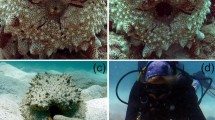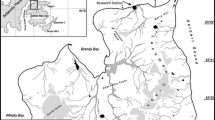Synopsis
Twenty-two samples of sand-dwelling fishes were collected from sublittoral sandy substrata off the Cape Peninsula, South Africa using a novel quantitative technique in which the ichthyocide, rotenone, was introduced beneath 6.25 m2 plastic sheets weighted around the perimeter with chain. A total of 94 fish of eight species and four families were recorded. Of these, four species of the family Clinidae made up 92% of the material. Fish densities varied from 0.10–2.96 fish m−2 (0.17–1.14 g m−2). Distribution patterns amongst the Clinidae were explained by sediment particle size, with all of the newly discovered species, Cancelloxus longior, inhabiting fine sand (median grain size 0.25–0.50 mm), and all Xenopoclinus leprosus, C. elongatus and Pavoclinus smalei occurring in gravel (> 1 mm). Xenopoclinus kochi was found in all sediment types, but was most abundant in coarse substrata. Diets of all four species were similar, consisting chiefly of amphipods and isopods. However, small differences in prey preference were evident. All four species reached sexual maturity at 25–30 mm standard length, were viviparous, exhibited superembryonation and gave ‘birth’ to live young of approximately 14 mm. Breeding seasonality occurred in all species except P. smalei.
Similar content being viewed by others
References cited
Atkinson, R.J.A. 1976. Some preliminary field observations of the burrows of the red band fish, Cepola rubescens. J. Fish Biol. 9: 181–183.
Atkinson, R.J.A. 1986. Mud-burrowing megafauna of the Clyde Sea area. Trans. Roy. Soc. Edinb. 90: 351–361.
Atkinson, R.J.A., R.S.V. Pullin & F.A. Dipper, 1977. Studies on the red band-fish, Cepola rubescens. J. Zool. Lond. 182: 369–384.
Atkinson, R.J.A., B. Pelster, C.R. Bridges, A.C. Taylor & S. Morris. 1987. Behavioural and physiological adaptations to a burrowing lifestyle in the snake blenny, Lumpenus lampretaeformis, and the red band-fish, Cepola rubescens. J. Fish Biol. 31: 639–659.
Bennett, B.A. 1989. The diets of fish in three southwestern Cape estuarine systems. S. Aft. J. Zool. 24: 163–177.
Berg, J. 1979. Discussion of methods of investigating the food of fishes, with reference to a preliminary study of the prey of Gobiusculus flavenscus (Gobiidae). Mar. Biol. 50: 263–273.
Bridges, C.R., A.C. Taylor & R.J.A. Atkinson. 1982. Respiratory properties of the blood of the burrowing red band fish Cepola rubescens L. J. exp. mar. Biol. Ecol. 59: 51–60.
Colclough, J.H. 1982. The ecology of the sandy sublittoral fish fauna of the Cape Peninsula with specific reference to the family Xenopoclinidae. Honours Project, University of Cape Town, Cape Town. 44 pp.
Day, J.H. 1974. A guide to marine life on South African shores. A.A. Balkema, Cape Town. 300 pp.
Gibson, R.N. & I.A. Ezzi. 1978. The biology of a Scottish population of Fries' goby, Lesueurigobius friesii. J. Fish Biol. 12: 371–389.
Gordon, J.D.M. & J.A.R. Duncan. 1979. Some notes on the biology of the snake blenny, Lumpenus lampretaeformis on the west coast of Scotland. J. mar. biol. Ass. U.K. 59: 413–419.
Grace, R.V. 1971. A checklist of fishes from the entrance to the Whangateau Harbour, Northland, New Zealand. Tane. 17: 129–136.
Griffiths, C.L. 1976. Guide to the Benthic Marine Amphipods of Southern Africa. South African Museum, Cape Town. 106 pp.
Heemstra, P.C. & J.E. Wright. 1986. Two new species of clinid fishes (Perciformes: Clinidae) from South Africa. Spec. Publ. J.L.B. Smith Inst. Ichthyol. 40: 1–11.
Hughes, G.M. & C.M. Ballintijn. 1968. Electromyography of the respiratory muscles and gill water flow in the dragonet. J. exp. Biol. 49: 583–602.
Hughes, G.M. & B. Knights. 1968. The effect of loading the respiratory pumps on the oxygen consumption of Callionymus lyra. J. exp. Biol. 49: 603–615.
Hughes, G.M. & S.-I. Umezawa. 1968. On respiration in the dragonet Callionymus lyra L. J. exp. Biol. 49: 565–582.
Karplus, I. 1987. The association between gobiid fishes and burrowing alpheid shrimps. Oceanogr. mar. Biol. Ann. Rev. 25: 507–562.
Kensley, B. 1978. Guide to the Marine Isopods of Southern Africa. South African Museum, Cape Town. 173 pp.
Lewis, D.B. 1976. Studies on the biology of the lesser weever fish Trachinus vipera Cuvier. I. Adaptations to a benthic habit. J. Fish Biol. 8: 127–138.
Macdonald, C.K. 1975. Notes on the family Gobiidae from Anaheim Bay. Fish. Bull. Calif. 165: 117–121.
Nash, R.D.M. 1980. Laboratory observations on the burrowing of the snake blenny, Lumpenus lampretaeformis (Walbaum), in soft sediment. J. Fish Biol. 16: 639–648.
Nash, R.D.M. 1982. The biology of Fries' goby, Lesueurigobius friesii (Malm), in the Firth of Clyde, Scotland, and a comparison with other stocks. J. Fish Biol. 21: 69–85.
Nash, R.D.M., C.J. Chapman, R.J.A. Atkinson & P.J. Morgan. 1984. Observations of the burrows and burrowing behaviour of Calocaris macandreae (Crustacea: Decapoda: Thalassinoidea). J. Zool. Lond. 202: 425–439.
Prochazka, K. & C.L. Griffiths. 1991. Cancelloxus longior, a new species of xenopoclinin fish (Perciformes: Clinidae) from South Africa. Spec. Publ. J.L.B. Smith Inst. Ichthyol. 51: 1–6.
Pullin, R.S.V., D.J. Morris, C.R. Bridges & R.J.A. Atkinson. 1980. Aspects of the respiratory physiology of the burrowing fish Cepola rubescens L. Comp. Biochem. Physiol. 66A: 35–42.
Rao, V.V. 1969. Sexual dimorphism in colouration among band fishes of the family Cepolidae. J. Bombay nat. Hist. Soc. 66: 388–390.
Rice, A.L. & A.D.F. Johnstone. 1972. The burrowing behaviour of the gobiid fish Lesueurigobius friesii (Collett). Z. Tierpsychol. 30: 431–438.
Smith, J.L.B. 1947. New clinid fishes from the south western Cape with notes on other fishes. Ann. Mag. Nat. Hist. 14 (Ser. 11): 732–736.
Smith, J.L.B. 1961. Fishes of the family Xenopoclinidae. Ichthyol. Bull. Rhodes Univ. 20: 351–356.
Smith, M.M & P.C. Heemstra (ed.). 1988. Smith's sea fishes. Southern Book Publishers, Johannesburg, 1047 pp.
Veith W.J. 1979. Reproduction in the live-bearing teleost Clinus superciliosus. S. Afr. J. Zool. 14: 208–211.
Author information
Authors and Affiliations
Rights and permissions
About this article
Cite this article
Prochazka, K., Griffiths, C.L. Observations on the distribution patterns, behaviour, diets and reproductive cycles of sand-dwelling clinids (Perciformes: Clinidae) from South Africa. Environ Biol Fish 35, 371–379 (1992). https://doi.org/10.1007/BF00004989
Received:
Accepted:
Issue Date:
DOI: https://doi.org/10.1007/BF00004989




